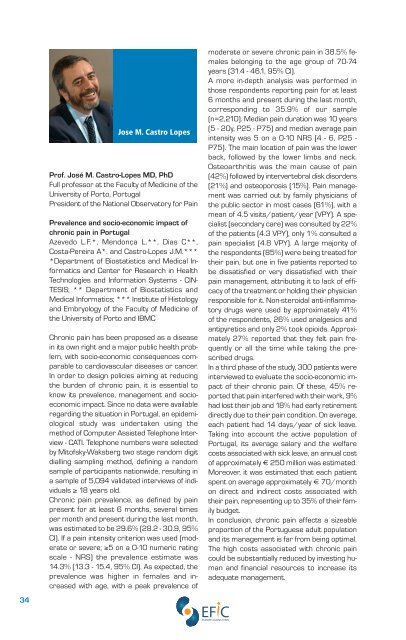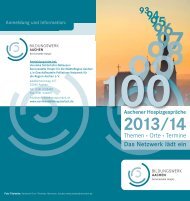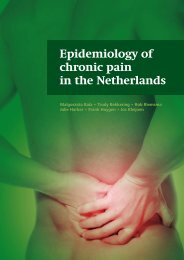First EFIC® Symposium Societal Impact of Pain - SIP
First EFIC® Symposium Societal Impact of Pain - SIP
First EFIC® Symposium Societal Impact of Pain - SIP
Create successful ePaper yourself
Turn your PDF publications into a flip-book with our unique Google optimized e-Paper software.
34<br />
Jose M. Castro Lopes<br />
Pr<strong>of</strong>. José M. Castro-Lopes MD, PhD<br />
Full pr<strong>of</strong>essor at the Faculty <strong>of</strong> Medicine <strong>of</strong> the<br />
University <strong>of</strong> Porto, Portugal<br />
President <strong>of</strong> the National Observatory for <strong>Pain</strong><br />
Prevalence and socio-economic impact <strong>of</strong><br />
chronic pain in Portugal<br />
Azevedo L.F.*, Mendonça L.**, Dias C**,<br />
Costa-Pereira A*. and Castro-Lopes J.M.***<br />
*Department <strong>of</strong> Biostatistics and Medical Informatics<br />
and Center for Research in Health<br />
Technologies and Information Systems - CIN-<br />
TESIS; ** Department <strong>of</strong> Biostatistics and<br />
Medical Informatics; *** Institute <strong>of</strong> Histology<br />
and Embryology <strong>of</strong> the Faculty <strong>of</strong> Medicine <strong>of</strong><br />
the University <strong>of</strong> Porto and IBMC<br />
Chronic pain has been proposed as a disease<br />
in its own right and a major public health problem,<br />
with socio-economic consequences comparable<br />
to cardiovascular diseases or cancer.<br />
In order to design policies aiming at reducing<br />
the burden <strong>of</strong> chronic pain, it is essential to<br />
know its prevalence, management and socioeconomic<br />
impact. Since no data were available<br />
regarding the situation in Portugal, an epidemiological<br />
study was undertaken using the<br />
method <strong>of</strong> Computer Assisted Telephone Interview<br />
- CATI. Telephone numbers were selected<br />
by Mit<strong>of</strong>sky-Waksberg two stage random digit<br />
dialling sampling method, defining a random<br />
sample <strong>of</strong> participants nationwide, resulting in<br />
a sample <strong>of</strong> 5,094 validated interviews <strong>of</strong> individuals<br />
≥ 18 years old.<br />
Chronic pain prevalence, as defined by pain<br />
present for at least 6 months, several times<br />
per month and present during the last month,<br />
was estimated to be 29.6% (28.2 - 30.9, 95%<br />
CI). If a pain intensity criterion was used (moderate<br />
or severe; ≥5 on a 0-10 numeric rating<br />
scale - NRS) the prevalence estimate was<br />
14.3% (13.3 - 15.4, 95% CI). As expected, the<br />
prevalence was higher in females and increased<br />
with age, with a peak prevalence <strong>of</strong><br />
moderate or severe chronic pain in 38.5% females<br />
belonging to the age group <strong>of</strong> 70-74<br />
years (31.4 - 46.1, 95% CI).<br />
A more in-depth analysis was performed in<br />
those respondents reporting pain for at least<br />
6 months and present during the last month,<br />
corresponding to 35.9% <strong>of</strong> our sample<br />
(n=2,210). Median pain duration was 10 years<br />
(5 - 20y, P25 - P75) and median average pain<br />
intensity was 5 on a 0-10 NRS (4 - 6, P25 -<br />
P75). The main location <strong>of</strong> pain was the lower<br />
back, followed by the lower limbs and neck.<br />
Osteoarthritis was the main cause <strong>of</strong> pain<br />
(42%) followed by intervertebral disk disorders<br />
(21%) and osteoporosis (15%). <strong>Pain</strong> management<br />
was carried out by family physicians <strong>of</strong><br />
the public sector in most cases (61%), with a<br />
mean <strong>of</strong> 4.5 visits/patient/year (VPY). A specialist<br />
(secondary care) was consulted by 22%<br />
<strong>of</strong> the patients (4.3 VPY), only 1% consulted a<br />
pain specialist (4.8 VPY). A large majority <strong>of</strong><br />
the respondents (85%) were being treated for<br />
their pain, but one in five patients reported to<br />
be dissatisfied or very dissatisfied with their<br />
pain management, attributing it to lack <strong>of</strong> efficacy<br />
<strong>of</strong> the treatment or holding their physician<br />
responsible for it. Non-steroidal anti-inflammatory<br />
drugs were used by approximately 41%<br />
<strong>of</strong> the respondents, 26% used analgesics and<br />
antipyretics and only 2% took opioids. Approximately<br />
27% reported that they felt pain frequently<br />
or all the time while taking the prescribed<br />
drugs.<br />
In a third phase <strong>of</strong> the study, 300 patients were<br />
interviewed to evaluate the socio-economic impact<br />
<strong>of</strong> their chronic pain. Of these, 45% reported<br />
that pain interfered with their work, 9%<br />
had lost their job and 18% had early retirement<br />
directly due to their pain condition. On average,<br />
each patient had 14 days/year <strong>of</strong> sick leave.<br />
Taking into account the active population <strong>of</strong><br />
Portugal, its average salary and the welfare<br />
costs associated with sick leave, an annual cost<br />
<strong>of</strong> approximately € 250 million was estimated.<br />
Moreover, it was estimated that each patient<br />
spent on average approximately € 70/month<br />
on direct and indirect costs associated with<br />
their pain, representing up to 35% <strong>of</strong> their family<br />
budget.<br />
In conclusion, chronic pain affects a sizeable<br />
proportion <strong>of</strong> the Portuguese adult population<br />
and its management is far from being optimal.<br />
The high costs associated with chronic pain<br />
could be substantially reduced by investing human<br />
and financial resources to increase its<br />
adequate management.






